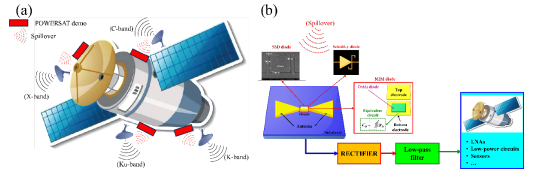POWERSAT PROJECT
Concept of Powersat Project
POWERSAT focuses on scavenging the unexploited solar infrared (IR) spectrum by providing an original THz (10-400 THz) energy harvesting platform, thus completing the function of photovoltaics cells, and on harvesting the microwave spillover losses from satellite’s antennas and transform them into a DC power supply.
POWERSAT will deliver an original solar-microwave combined platform based on rectennas to harvest a big part of the IR radiation coming from the sun and the spillover electric field radiated by satellite’s antennas in four main bands.
This harvested energy will be employed to fuel the low-power embedded electronics within satellites, including components like low-noise amplifiers, various sensors, and oscillators. Moreover, antennas designed for energy harvesting can also facilitate efficient and low-power inter-satellite links (ISLs). Satellites are often arranged in constellations, flying in formation as they orbit Earth. In such configurations, satellites can establish communication links with neighboring satellites using RF or laser links. These ISLs enable satellites to connect with others, allowing data to traverse different gateways within the satellite network. To achieve this, POWERSAT will propose five demonstrators, i.e., a solar energy harvesting platform integrating micro/nanoantennas and MIM diode-based rectifiers, and four demonstrators integrating several rectennas, each demonstrator being suitable for one of the four microwave bands mentioned before. These same antenna arrays will be instrumental in enabling low-power backscattering communications. The final goal is to provide a seamless integration of the newly developed rectennas into satellite’s electronic systems, which in perspective will allow the future partial replacement of satellite’s solar cells, thus lowering satellite’s overall weight and, hence, the launch costs.

The ambition of POWERSAT has three main targets:
- To scavenge the unexploited solar spectrum by providing an original THz (10-400 THz ≈ 30 μm-750 nm) energy harvesting platform, thus complementing the function of photovoltaics (PV) cells.
- To harvest the microwave spillover losses from satellite’s antennas and transform them into a practical DC power supply.
- To facilitate efficient and low-power inter-satellite links (ISLs).
All in all, POWERSAT will introduce the concept of combined solar and microwave energy harvesting in satellites. This harvested energy will be employed to fuel the low-power embedded electronics within satellites, including components like low-noise amplifiers, various sensors, and oscillators. Moreover, rectennas designed for energy harvesting can also be used for ISLs. To achieve this, we plan to create novel rectenna arrays, which integrate antennas with zero-bias rectifiers. These same antenna arrays will be instrumental in enabling low-power backscattering communications. The final goal is to provide a seamless integration of the newly developed rectennas into satellite’s electronic systems, which in perspective will also allow the future partial replacement of satellite’s solar cells, thus lowering satellite’s overall weight and, hence, the launch costs.
The technological breakthrough of SMARTWAY relies on the integration of the following components into the standard high-volume and cost-effective silicon-based technologies to propose radical and innovative solutions: 1) Metamaterials, 2) Two-dimensional material-based antennas, and 3) Carbon nanotube-based filters and switches.
Powersat Objectives:
The main objectives of Powersat are listed in the following:
1) Objective 1:
High-efficiency antennas for in-orbit solar and microwave energy harvesting on satellite and backscattering/beamforming communications
2) Objective 2:
Rectifying diodes with a high THz-to-DC and RF-to-DC conversion efficiency, monolithically integrated with antennas for low-profile, lightweight, and low-cost THz and microwave energy harvesters.
3) Objective 3:

The Powersat project is funded by HORIZON-EIC-2023-PATHFINDER CHALLENGES-01 under the grant agreement 101162320
About Powersat
POWERSAT is developing a new energy harvesting platform that captures unused solar infrared (IR) energy and microwave spillover from satellite antennas. It uses rectennas to gather energy from various microwave bands to power low-energy satellite electronics. The project includes five demonstrators and aims to connect satellites through low-power inter-satellite links while reducing overall satellite weight and launch costs.
CONSORTIUM





